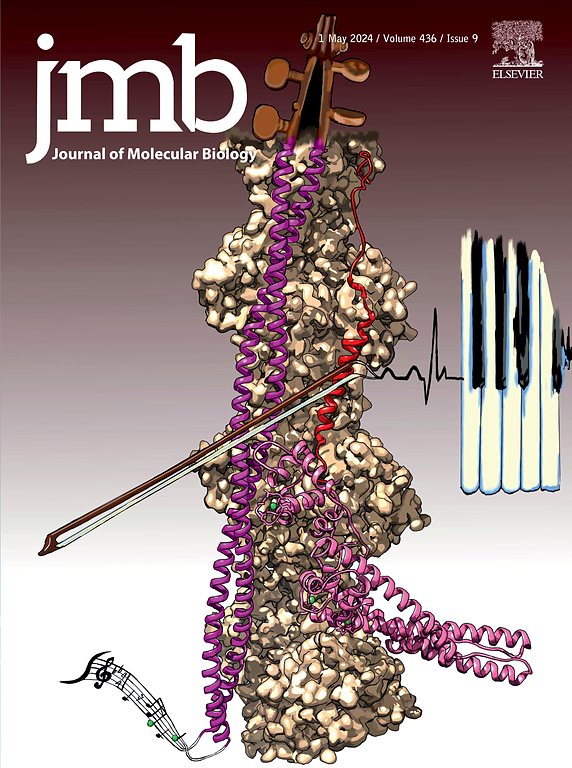SAMD12通过与CNKSR2支架解耦激酶作为MAP4Ks的主调控因子。
IF 4.7
2区 生物学
Q1 BIOCHEMISTRY & MOLECULAR BIOLOGY
引用次数: 0
摘要
MAP4K成员TNIK和多结构域支架蛋白CNKSR2都聚集在神经元突触上,它们相互作用并与神经发育障碍密切相关,尽管它们相互作用的机制尚不清楚。在本研究中,我们表征了MAP4K激酶(MAP4K4、MINK1和TNIK)与CNKSR1/2/3支架蛋白之间的相互作用机制,发现家族性成人肌阵挛性癫痫基因产物SAMD12或其近同源物SAMD10与CNKSR1/2/3具有异常强的亲和力,可以定量取代CNKSR1/2/3支架上的MAP4K。此外,我们证明了CNKSR2在神经元突触发育过程中同时作为TNIK的支架和激活剂。SAMD12的异位表达可以有效地改变突触的发育,可能是通过与CNKSR2分离来抑制TNIK活性。我们的发现可能对MAP4Ks和CNKSR1/2/3在神经系统和其他组织生理和病理生理过程中的作用具有广泛的意义。本文章由计算机程序翻译,如有差异,请以英文原文为准。

SAMD12 as a Master Regulator of MAP4Ks by Decoupling Kinases From the CNKSR2 Scaffold
The MAP4K member TNIK and the multi-domain scaffold protein CNKSR2, both of which are clustered at neuronal synapses, interact with each other and are closely associated with neurodevelopmental disorders, although the mechanism underlying their interaction is unclear. In this study, we characterized the interaction mechanisms between MAP4K kinases (MAP4K4, MINK1 and TNIK) and the CNKSR1/2/3 scaffold proteins, and discovered that SAMD12, a familial adult myoclonic epilepsy disease gene product, or its close homolog SAMD10, binds to CNKSR1/2/3 with exceptionally strong affinities and can quantitatively displace MAP4K from CNKSR1/2/3 scaffolds. Additionally, we demonstrated that CNKSR2 acts as both a scaffold and an activator of TNIK during neuronal synapse development. Ectopic expression of SAMD12 can effectively alter synapse development, likely by inhibiting TNIK activity through the dissociation of the kinase from CNKSR2. Our findings may have broad implications on the roles of MAP4Ks and CNKSR1/2/3 in the nervous system and in other tissues under physiological and pathophysiological processes.
求助全文
通过发布文献求助,成功后即可免费获取论文全文。
去求助
来源期刊

Journal of Molecular Biology
生物-生化与分子生物学
CiteScore
11.30
自引率
1.80%
发文量
412
审稿时长
28 days
期刊介绍:
Journal of Molecular Biology (JMB) provides high quality, comprehensive and broad coverage in all areas of molecular biology. The journal publishes original scientific research papers that provide mechanistic and functional insights and report a significant advance to the field. The journal encourages the submission of multidisciplinary studies that use complementary experimental and computational approaches to address challenging biological questions.
Research areas include but are not limited to: Biomolecular interactions, signaling networks, systems biology; Cell cycle, cell growth, cell differentiation; Cell death, autophagy; Cell signaling and regulation; Chemical biology; Computational biology, in combination with experimental studies; DNA replication, repair, and recombination; Development, regenerative biology, mechanistic and functional studies of stem cells; Epigenetics, chromatin structure and function; Gene expression; Membrane processes, cell surface proteins and cell-cell interactions; Methodological advances, both experimental and theoretical, including databases; Microbiology, virology, and interactions with the host or environment; Microbiota mechanistic and functional studies; Nuclear organization; Post-translational modifications, proteomics; Processing and function of biologically important macromolecules and complexes; Molecular basis of disease; RNA processing, structure and functions of non-coding RNAs, transcription; Sorting, spatiotemporal organization, trafficking; Structural biology; Synthetic biology; Translation, protein folding, chaperones, protein degradation and quality control.
 求助内容:
求助内容: 应助结果提醒方式:
应助结果提醒方式:


